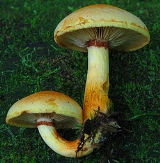
Gymnopilus luteus
Encyclopedia
Gymnopilus luteus also called the "Yellow Gymnopilus" is a widely distributed mushroom of the Eastern United States
, it contains the hallucinogens psilocybin
and psilocin
. Often mistaken for Gymnopilus junonius
.
Eastern United States
The Eastern United States, the American East, or simply the East is traditionally defined as the states east of the Mississippi River. The first two tiers of states west of the Mississippi have traditionally been considered part of the West, but can be included in the East today; usually in...
, it contains the hallucinogens psilocybin
Psilocybin
Psilocybin is a naturally occurring psychedelic prodrug, with mind-altering effects similar to those of LSD and mescaline, after it is converted to psilocin. The effects can include altered thinking processes, perceptual distortions, an altered sense of time, and spiritual experiences, as well as...
and psilocin
Psilocin
Psilocin , an aromatic compound, sometimes also spelled psilocine, psilocyn, or psilotsin, is a psychedelic mushroom alkaloid. It is found in most psychedelic mushrooms together with its phosphorylated counterpart psilocybin...
. Often mistaken for Gymnopilus junonius
Gymnopilus junonius
Gymnopilus junonius is a species of mushroom in the Cortinariaceae family. Commonly known as laughing gym, laughing Jim, or the spectacular rustgill, this large orange mushroom is typically found growing on tree stumps, logs, or tree bases...
.
Description
- PileusPileus (mycology)The pileus is the technical name for the cap, or cap-like part, of a basidiocarp or ascocarp that supports a spore-bearing surface, the hymenium. The hymenium may consist of lamellae, tubes, or teeth, on the underside of the pileus...
: 5 — 10(15) cm, Convex or nearly flat with an incurved margin that slightly overhangs the gills. Buff yellow to warm buff orange, often slightly darker towards the center, dry, smooth, silky or finely floccose-fibrillose, sometimes floccose-sqaumulose toward the center, flesh firm, pale yellow. Staining orange-brownish or sometimes bluish-green where injured or on age. - Gills: Adnexed, thin, close, pale yellow, becoming rusty brown with age.
- Spore Print: Rusty brown.
- StipeStipe (mycology)thumb|150px|right|Diagram of a [[basidiomycete]] stipe with an [[annulus |annulus]] and [[volva |volva]]In mycology a stipe refers to the stem or stalk-like feature supporting the cap of a mushroom. Like all tissues of the mushroom other than the hymenium, the stipe is composed of sterile hyphal...
: 4 — 8(9) cm, .5 — 1.5 cm thick, equal to slightly enlarging below, solid, firm, colored like the cap, developing yellowish-rusty stains when handled, finely hairy, partial veil usually forms a fragile submembraneous ring or fibrillose annular zone near the apex. Staining orange-brownish or sometimes bluish-green where injured or in age. - Taste: Bitter.
- Odor: Pleasant.
- Microscopic features: Spores 6 — 9 x 4 — 5(5.5) µm minutely warty, elliptical, dextrinoid, surface finely roughened, no germ pore. Pleurocystidia present, cheilocystidia scarcely projecting beyond the basidia, variously shaped. Caulocystidia absent. Clamp connections present.

